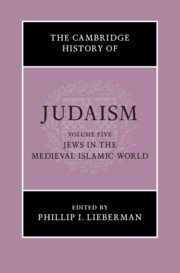Book contents
- The Cambridge History of Judaism
- The Cambridge History of Judaism
- The Cambridge History of Judaism
- Copyright page
- Contents
- Figures
- Acknowledgments
- Introduction
- Part I Jews in the Medieval Islamic World
- A. The Islamic World in the Middle Ages
- B. Regional Surveys
- Chapter 4 The Maghrib and Egypt
- Chapter 5 The Jews of Muslim Spain
- Chapter 6 Beyond Crescent and Cross
- Chapter 7 Yemen and India from the rise of Islam to 1500
- Chapter 8 The Jews of Northern Arabia in Early Islam
- Chapter 9 Judaism in Pre-Islamic Arabia
- Chapter 10 The Islamic East
- Part II Social and Institutional History
- Part III Spiritual and Intellectual History
- Index
- References
Chapter 5 - The Jews of Muslim Spain
from B. - Regional Surveys
Published online by Cambridge University Press: 21 August 2021
- The Cambridge History of Judaism
- The Cambridge History of Judaism
- The Cambridge History of Judaism
- Copyright page
- Contents
- Figures
- Acknowledgments
- Introduction
- Part I Jews in the Medieval Islamic World
- A. The Islamic World in the Middle Ages
- B. Regional Surveys
- Chapter 4 The Maghrib and Egypt
- Chapter 5 The Jews of Muslim Spain
- Chapter 6 Beyond Crescent and Cross
- Chapter 7 Yemen and India from the rise of Islam to 1500
- Chapter 8 The Jews of Northern Arabia in Early Islam
- Chapter 9 Judaism in Pre-Islamic Arabia
- Chapter 10 The Islamic East
- Part II Social and Institutional History
- Part III Spiritual and Intellectual History
- Index
- References
Summary
In 711, a small Muslim invading force composed of Arabs and Berbers crossed the Straits of Gibraltar from North Africa and began a military campaign that overthrew the Visigothic Kingdom and inaugurated a new chapter in Islamic and European history. It also marked the beginning of a new era in Jewish history. The Arabs applied the name al-Andalus to the newly acquired Iberian territory, probably recalling the Vandals, one of the Germanic tribal groups who formed the prior Christian kingdom. Henceforth, the Iberian Peninsula under Muslim rule would be known as Andalusia or al-Andalus. Al-Andalus endured for almost 800 years in an ever-contracting territory until its last stronghold, the Nāṣrid Kingdom of Granada, fell in 1492. Since the end of the fifteenth century, the name Andalusia has denoted the small southwestern province at the tip of the Iberian Peninsula; the entire, unified, peninsula became known as Spain. The Jews recall the area as Sepharad and its Jewish inhabitants and their descendants are designated Sephardim.
- Type
- Chapter
- Information
- The Cambridge History of Judaism , pp. 164 - 198Publisher: Cambridge University PressPrint publication year: 2021
References
Select Bibliography
- 1
- Cited by



